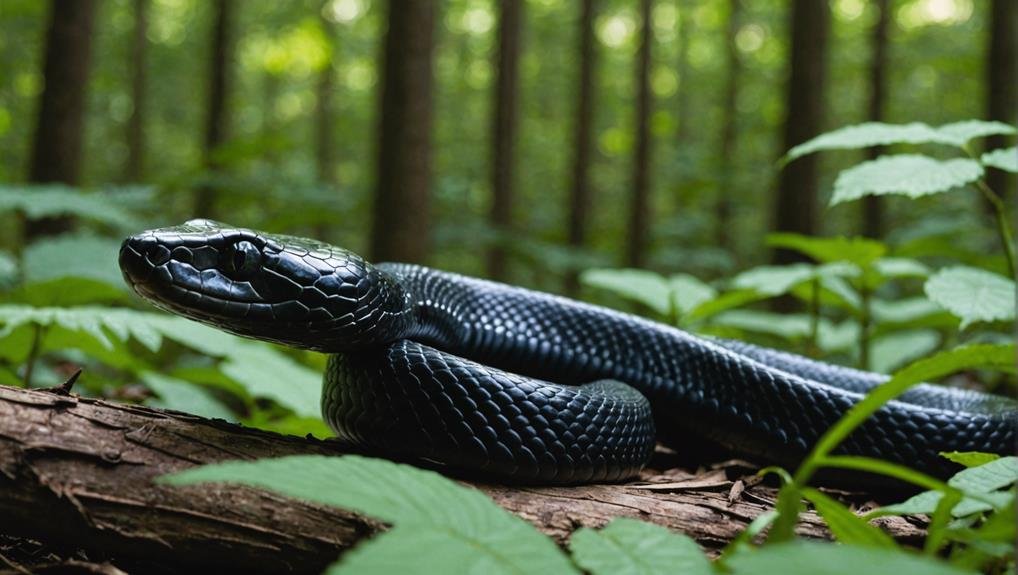When you think about Arkansas’s wildlife, black snakes might not be the first to come to mind. Yet, these non-venomous constrictors, such as the Black Rat Snake, play a pivotal role in maintaining the balance of local ecosystems. Their sleek, glossy bodies and impressive climbing abilities make them fascinating inhabitants of forests, swamps, and even urban areas. But there’s more to their story than just their appearance and habitat. How do these snakes contribute to controlling rodent populations, and what makes them essential to our environment? Let’s explore their intriguing world further.
Key Takeaways
- Black snakes like the Black Rat Snake in Arkansas are non-venomous constrictors.
- They inhabit diverse environments, including forests, rocky hillsides, swamps, and urban areas.
- Black snakes regulate rodent populations and maintain ecosystem balance.
- They are excellent climbers and swimmers, growing up to 6 feet long.
- Misidentification leads to unnecessary fear; they are generally harmless to humans.
Overview of Black Snakes
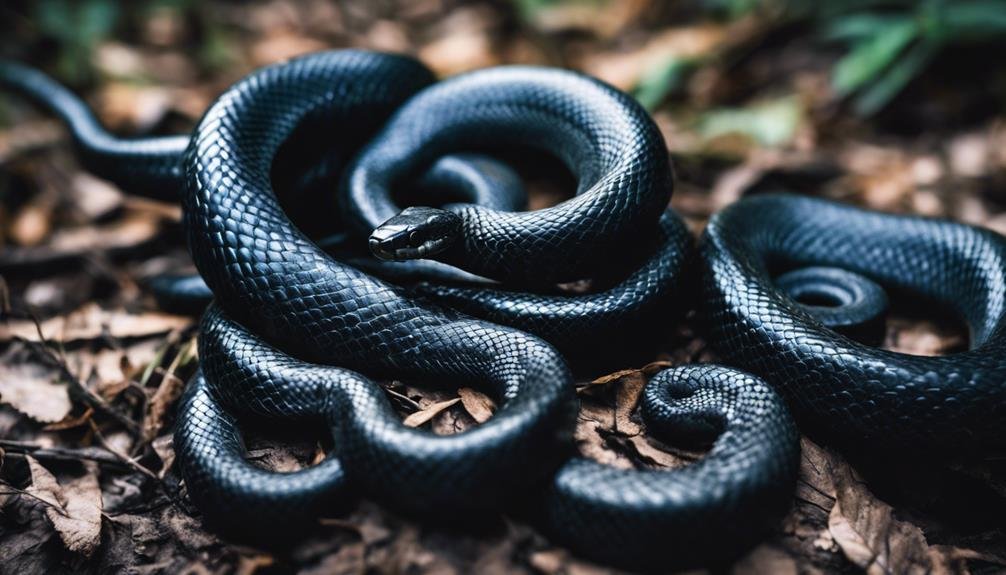

Black snakes in Arkansas are captivating, essential, non-venomous constrictors that play a crucial role in maintaining the ecosystem by controlling rodent populations. Among these, the Black Rat Snake stands out. This particular species, often with specks of white or gray on its otherwise glossy black body, is a frequent sight in the region. They’re known for their impressive length, sometimes reaching up to 6 feet, and their smooth, slender bodies make them excellent climbers and swimmers.
You’ll be fascinated to know that Black Rat Snakes are naturally quite docile. However, when threatened, they might vibrate their tails, making them mistaken for venomous snakes like rattlesnakes. This defensive behavior is just one of the many intriguing aspects of their behavior.
Their diverse diet includes rodents, birds, eggs, and small mammals. By keeping these prey populations in check, Black Rat Snakes play a significant role in the ecosystem’s health. Their presence ensures that the balance between predator and prey is maintained, highlighting their importance beyond just their captivating appearance.
Understanding these remarkable snakes is key to appreciating their role in Arkansas’s natural world.
Habitat and Distribution
Arkansas Black Rat Snakes can be found in various habitats, including forests, rocky hillsides, and swamps. They also adapt well to urban areas, often taking shelter in abandoned buildings.
Their movement patterns change throughout the year as they hibernate in winter and are more active in warmer months.
Preferred Living Environments
Arkansas Black Rat Snakes are essential in diverse habitats such as forests, rocky hillsides, swamps, and urban areas where prey is abundant. They’re quite adaptable, often taking advantage of various nesting sites like abandoned buildings or barns. These spots provide shelter and food for a variety of rodents and birds.
Environmental factors play a significant role in determining where these snakes settle. They prefer areas with ample cover and access to water sources such as streams and rivers. These conditions help them regulate their body temperature and find sufficient prey. In swamps and forests, you’ll often see them basking in the sun or hiding under rocks and logs.
The population dynamics of the Arkansas Black Rat Snake are closely tied to these environments. When plentiful prey is available, these snakes can thrive and maintain healthy population levels. Conversely, a scarcity of food or changes in habitat due to urban development can impact their numbers.
Despite these challenges, their ability to adapt to various environments, including urban areas, helps them remain an integral part of Arkansas’s ecosystem, especially in controlling rodent populations.
Geographic Range in Arkansas
Although their presence spans various environments, you’ll most commonly find these adaptable snakes in the forests, rocky hillsides, and near water sources across Arkansas. Black snakes, such as the Arkansas Black Rat Snake, thrive in areas where they can hunt rodents and birds, keeping their population density in check. Their behavior patterns include excellent climbing and swimming abilities, allowing them to navigate various terrains effortlessly.
In urban settings, these snakes often take refuge in abandoned buildings or barns, where human interaction becomes more frequent. BBlack snakes exhibit docile behavior patterns despite their intimidating appearance despite their intimidating appearance, only vibrating their tails when threatened. This non-aggressive nature reduces the likelihood of negative encounters with humans.
In Arkansas, black snakes are important in controlling rodent populations, benefiting natural ecosystems and human environments. Their adaptability to different habitats ensures they are widespread across the state, from rural areas to urban locales.
| Environment | Characteristics |
|---|---|
| Forests | High population density, abundant prey |
| Rocky Hillsides | Excellent climbing abilities, ideal for basking |
| Near Water Sources | Strong swimming skills, access to diverse prey |
| Urban Areas | Frequent human interaction, rodent control |
| Abandoned Buildings | Sheltered habitat, easy access to food sources |
Understanding their geographic range helps us appreciate their role in Arkansas’s Movement Patterns.
Black snakes in Arkansas shift between habitats like forests, rocky hillsides, and swamps depending on the season. These snakes adapt their migration patterns to optimize survival and reproduction.
In spring, their breeding habits drive them to areas with abundant prey and suitable mates. Forests are ideal for hunting and breeding due to ample food supply. Rocky hillsides provide shelter and temperature regulation. Swamps offer humidity and prey, essential during dry spells. Urban areas, such as abandoned buildings and barns, become refuges. Streams and rivers are necessary for hydration and prey availability.
Conversely, they often seek cooler, shaded environments near water sources during the hot summer.
In autumn, black snakes prepare for winter by increasing their food intake and seeking hibernation spots. These seasonal behaviors ensure they remain active and healthy throughout the year. During winter, they hibernate in safe, insulated environments, minimizing exposure to freezing temperatures.
Physical Characteristics
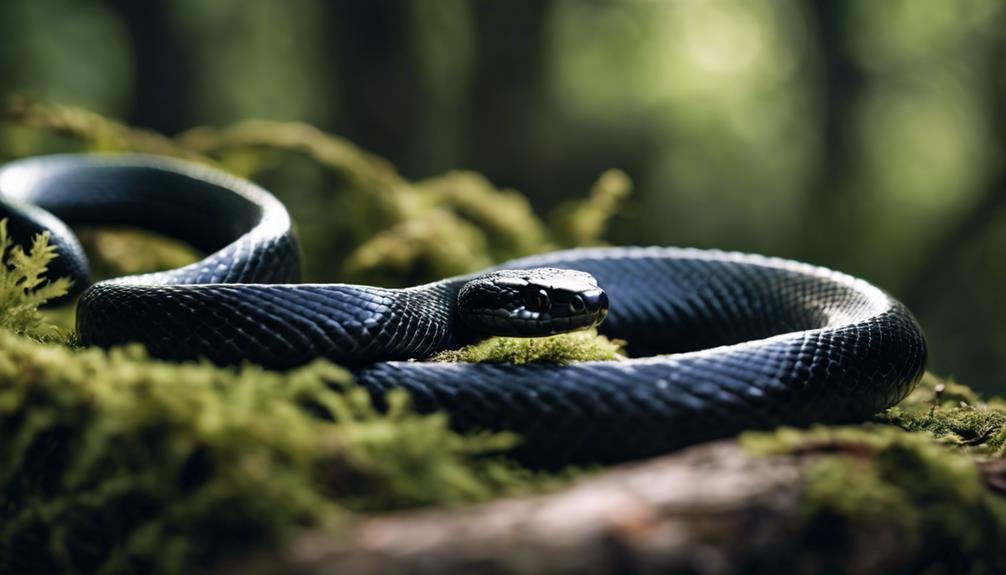

Sporting a sleek black coloration with a contrasting white underbelly, these snakes blend effortlessly into their forest and woodland habitats. Their slender bodies, covered in smooth scales, can grow up to 6 feet. You’ll notice how their physical traits enable them to easily navigate their environment, showcasing their excellent climbing and swimming abilities. These skills are essential for their survival and efficiency in controlling rodent populations.
Regarding reproductive habits, black snakes in Arkansas lay eggs, typically in hidden, warm places. The hatchlings emerge fully formed and self-sufficient, ready to start their lives in the wild. This reproduction method ensures their species’ reproduction method ensures their species’ continuity ensures their species’ continuity species due to their habit of vibrating their tails when threatened. This mimicry can deter potential predators by resembling the behavior of rattlesnakes. These non-venomous constrictors use their strength to subdue prey, employing effective predation techniques such as ambushing and constricting their targets.
Understanding these physical characteristics will help you appreciate these snakes’ essential role in Arkansas’s ecosystem.
Diet and Hunting Behavior
Black snakes in Arkansas’ essential roles, eggs, and small Black snakes’ diverse diets support their survival and growth. They employ ambush hunters, and a diverse diet is important for capturing their preferred food sources.
- Prey preferences: Rodents, birds, eggs, and small mammals.
- Hunting techniques: Ambush strategy and constriction.
- Digestive process: They consume prey whole, utilizing efficient energy.
- Post-meal behavior: They can go extended periods without food.
- Reproductive habits and mating rituals are not directly related to diet but influence population dynamics.
After a significant meal, black snakes showcase an impressive digestive process, breaking down their prey entirely and absorbing nutrients efficiently. This allows them to survive long intervals without eating again, demonstrating their remarkable energy utilization.
When hunting, black snakes naturally prefer areas abundant in their favored prey. Their ability to control rodent populations also indirectly benefits their reproductive habits and natural preferences. Understanding these aspects of their diet and hunting behavior helps highlight these snakes’ important role in their environment.
Role in the Ecosystem
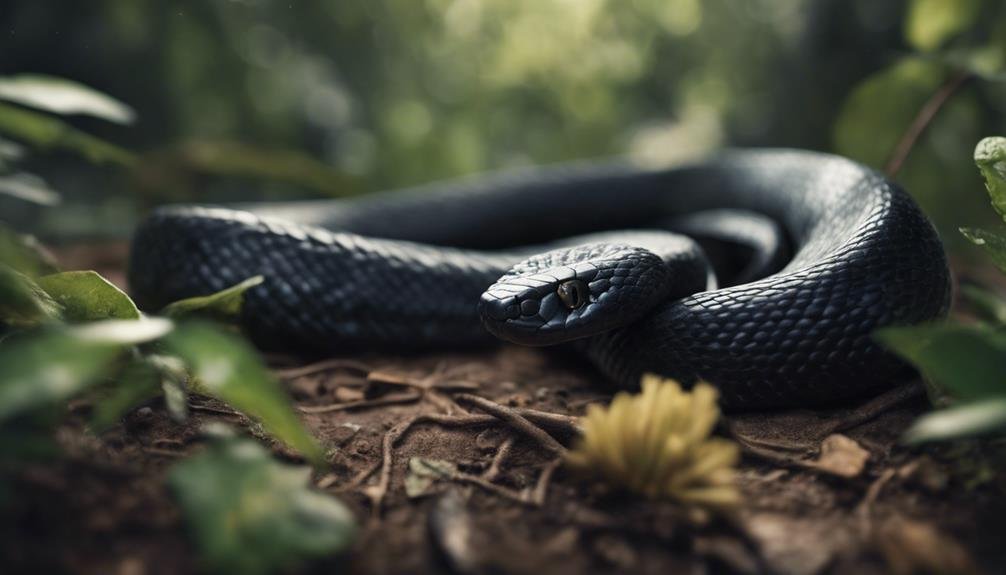

Understanding their diet and hunting behavior underscores how black snakes in Arkansas contribute to snakes’ important role in rodent populations. These non-venomous constrictors play a key role in predatory interactions that maintain ecosystem balance.
By preying on rodents, birds, and small mammals, black snakes help keep these populations in check, which is vital for food chain dynamics. When rodent numbers are controlled, it reduces the spread of diseases and prevents crop damage, benefiting both human communities and other wildlife.
Black snakes’ conservation importance can’t be overstated. Their presence in Arkansas’s forests and fields is a natural form of rodent control, making them invaluable to wildlife. Black snakes’ conservation goals are also important.
Black snakes’ docile nature and tendency to avoid confrontation make them non-threatening to humans, further emphasizing their role as beneficial predators in the ecosystem.
Common Misconceptions
You might think all black snakes are venomous, but that’s a common mistake.
Many people misidentify these harmless snakes, leading to unnecessary fear.
In reality, black snakes are generally non-venomous and pose no threat to humans.
Not All Venomous
Many people mistakenly believe that all black snakes in Arkansas are venomous, leading to unnecessary fear and confusion. Understanding the difference between venomous and non-venomous species is crucial to reducing anxiety and promoting safer interactions with these reptiles.
One of Arkansas’s most common black snakes, the non-venomous Arkansas Black Rat Snake, plays a pivotal role in controlling populations, highlighting its reducing anxiety and promoting trying to identify these snakes; consider the following:
- Black Rat Snakes have a sleek, glossy appearance and can grow large, sometimes exceeding six feet.
- Venomous snakes like the Cottonmouth have a more Cotton mouth built with a distinct Cotton modular head.
- Non-venomous snakes often have round pupils, while evil ones generally have elliptical pupils.
- Arkansas Black Rat Snakes are excellent climbers, often found in trees or barns.
- Venomous snakes, such as the Timber Rattlesnake, have a distinctive rattle at the end of their tails.
Understanding these characteristics helps you differentiate between venomous and non-venomous species, reducing unnecessary harm to these ecologically important creatures. Educating yourself and others contributes to more harmonious coexistence with black snakes in Arkansas.
Misidentified Species Often
Despite their harmless nature, black snakes in Arkansas are often misidentified as venomous species, fueling unnecessary fear and misconceptions. People frequently mistake them for more dangerous snakes like the CCottonmouth or the black CoCottonmouth. Does misidentification stem from their similar cotton mouth patterns, leading to unwarranted panic and sometimes harmful actions against these beneficial reptiles?
Focusing on public education is vital to enhancing snake identification. By learning black snakes’ distinguishing features and behaviors, you can better understand their role in the ecosystem. For instance, black snakes are excellent at controlling rodent populations, essential for maintaining a balanced environment.
Educating the public about these harmless constrictors can also promote wildlife conservation. When you know that black snakes aren’t aggressive or evil, you’re less likely to harm them out of fear. Instead, you can appreciate their presence and their benefits to your surroundings.
Understanding the differences between black snakes and venomous species is key. Simple steps like attending local wildlife workshops or reading educational materials can significantly impact. By spreading accurate information, you help reduce misconceptions and support the conservation of these important native reptiles.
Harmless to Humans
Why do so many people believe that black snakes in Arkansas pose a threat when they’re harmless to humans? The misconceptions stem from their menacing appearance and misunderstood behavioral patterns. Many people mistake these non-venomous constrictors for dangerous snakes, leading to unnecessary fear and hostility.
In reality, black snakes like the Arkansas Black Rat Snake are important to the environment and pose no harm to humans. Here are some key points to bear in mind:
- Vital: Their dark color and size often lead to mistaken identity.
- Defensive Behavior: When threatened, they may vibrate their tails, mimicking rattlesnakes.
- Ecological Role: They help control rodent populations, hence maintaining environmental balance.
- Non-Aggressive Nature: Black snakes are more likely to retreat than confront during human interaction.
- Urban Adaptation: They can thrive in urban environments, often seeking shelter in barns and sheds.
Understanding these facts can help dispel myths and promote peaceful coexistence. Black snakes are important for managing pests and should be seen as allies rather than threats. Education is key to changing the narrative and ensuring that humans and snakes can live harmoniously in Arkansas.
Identifying Black Snakes
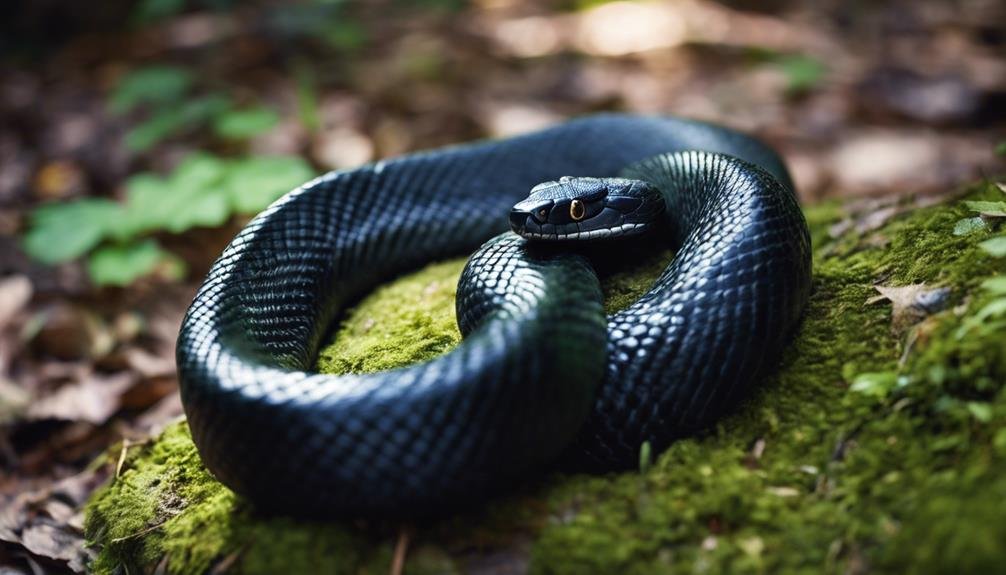

To identify black snakes in Arkansas, look for their distinctive black color contrasted with a white underbelly. These non-venomous constrictors are quite common and are easily recognizable due to their unique coloration. Note their smooth scales and slender, elongated bodies for accurate snake identification. They’re often found in diverse habitats such as forests, rocky hillsides, near water sources, and even urban areas.
Understanding their behavior patterns can also help you identify them. Black snakes are excellent climbers, frequently spotted in trees or high places. They exhibit docile behavior, but when threatened, they might vibrate their tails to mimic a rattlesnake, a clever defense mechanism. During the winter months, these snakes hibernate, emerging in the spring to mate, with egg-laying occurring in the summer.
Recognizing black snakes is essential for supporting conservation efforts. By identifying and understanding these snakes, you can appreciate their role in controlling rodent populations, which benefits both the ecosystem and human communities. Their presence is a sign of a healthy environment, and by protecting them, you contribute to biodiversity and ecological balance in Arkansas.
Safety Tips and Precautions
When you encounter black snakes in Arkansas, it is important to stay calm and keep your distance. Although black snakes are generally non-venomous, following proper safety precautions is vital to avoid unwanted incidents.
Here are some tips to guarantee your safety:
- Don’t provoke or corner: Avoid actions that could make the snake feel threatened and more likely to strike.
- Learn identification: Familiarize yourself with the characteristics of venomous and non-venomous snakes in Arkansas.
- Keep areas clear: Maintain your yard and outdoor spaces free of debris and clutter to minimize hiding spots.
- Use snake repellent: Consider safe and effective snake-repellent products as a preventive measure.
- Contact experts: If unsure about the snake’s identity, contact local wildlife authorities for professional snake handling and identification.
In case of a snake bite, prompt emergency response is essential. Call emergency services immediately and try to keep the affected area immobilized and lower than the heart.
There are prevention methods, like educating you to maintain a clean outdoor environment, which greatly reduce the likelihood of snake encounters. Prioritize these safety tips to coexist safely with black snakes in Arkansas.
Legal Protections
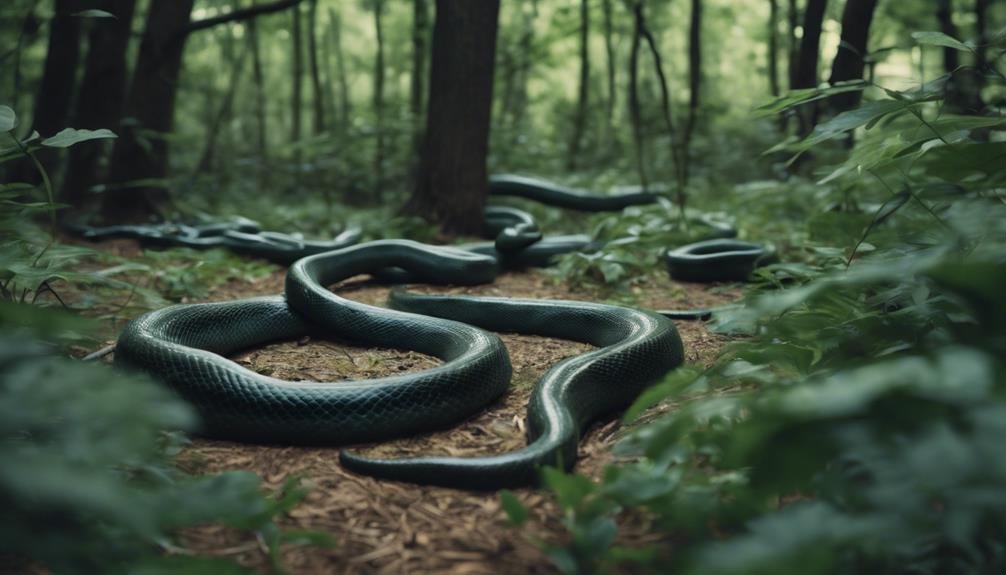

Legal protections for black snakes in Arkansas are crucial to guaranteeing their habitats remain safe and sustainable. These protections help mitigate threats like habitat loss and road mortality, which can profoundly impact population trends.
Despite not being listed as threatened, black rat snakes still face legal challenges in some states where specific regulations may apply. Understanding these laws can be the first step in aiding their preservation.
Human-wildlife conflict is another crucial issue. Black snakes often find themselves near human settlements, leading to potential conflicts. Effective management strategies are necessary to address these conflicts and promote harmonious coexistence.
By implementing measures such as safe relocation practices and habitat preservation, you can help reduce these risks.
Public awareness and community involvement are essential components of legal protection. Educating the public about the ecological benefits of black snakes can foster a more supportive environment for their conservation.
Community-driven initiatives can also play a significant role in mitigating human impact on snake habitats. By participating in local conservation programs and spreading awareness, you contribute to a collective effort that ensures black snakes continue to thrive in Arkansas.
Conservation Efforts
Effective conservation efforts for black snakes in Arkansas prioritize habitat protection and reducing road mortality. Focusing on these areas can help guarantee these important reptiles continue to thrive. Road ecology and conservation initiatives are essential in mitigating the risks black snakes face from vehicles.
To paint a clearer picture, here are some actionable steps involved:
- Habitat Preservation: Protecting and restoring natural habitats to provide safe living spaces for black snakes.
- Wildlife Crossings: Installing underpasses and overpasses to reduce road mortality.
- Public Education: Informing the public about the ecological benefits of black snakes to foster positive human-wildlife interactions.
- Population Monitoring: Regular population monitoring and research are conducted to track the health and numbers of black snakes.
- Legislation: Implementing and enforcing conservation laws to safeguard snake habitats and reduce human-induced threats.
You can help by supporting these initiatives and staying informed about black snakes’ role in the ecosystem.
Conclusion
By understanding black snakes in Arkansas, you’re better prepared to appreciate their role in the ecosystem. These non-venomous constrictors help keep rodent populations in check, benefiting nature and human communities.
Remember, they thrive in various habitats and are crucial for maintaining ecological balance. Respect their space, follow safety tips, and support conservation efforts to promote coexistence.
Together, we can guarantee these fascinating creatures continue to flourish in Arkansas.
FAQs
1. Are Any Black Snakes Poisonous?
No, black snakes aren’t poisonous. To understand venomous species, focus on snake identification and habitat preferences. Black snakes are generally non-venomous and help control rodent populations, making them beneficial for the ecosystem.
2. Are Black Rat Snakes in Arkansas?
Yes, you’ll find Black Rat Snakes in Arkansas. They prefer habitats like woodlands and forests and eat rodents, birds, and eggs. They’re non-venomous and play an important role in rodent control, though conservation is needed.
3. How Aggressive Are Black Snakes?
Black snakes aren’t aggressive but exhibit defensive behavior, like tail vibrations when facing potential threats. They prefer retreating to confrontation. Their habitat preferences include areas with ample rodent populations, emphasizing their important ecological role.
4. What Are the Black Snakes Near My House?
You might be seeing black kingsnakes or black racers near your house. Their behavior includes being non-aggressive and beneficial for pest control. For accurate snake identification, consider their habitat preferences and physical characteristics.
Related Article:
https://thereptileguide.com/leopard-gecko-morphs-exploring-varieties/
https://thereptileguide.com/bearded-dragon-shedding/

